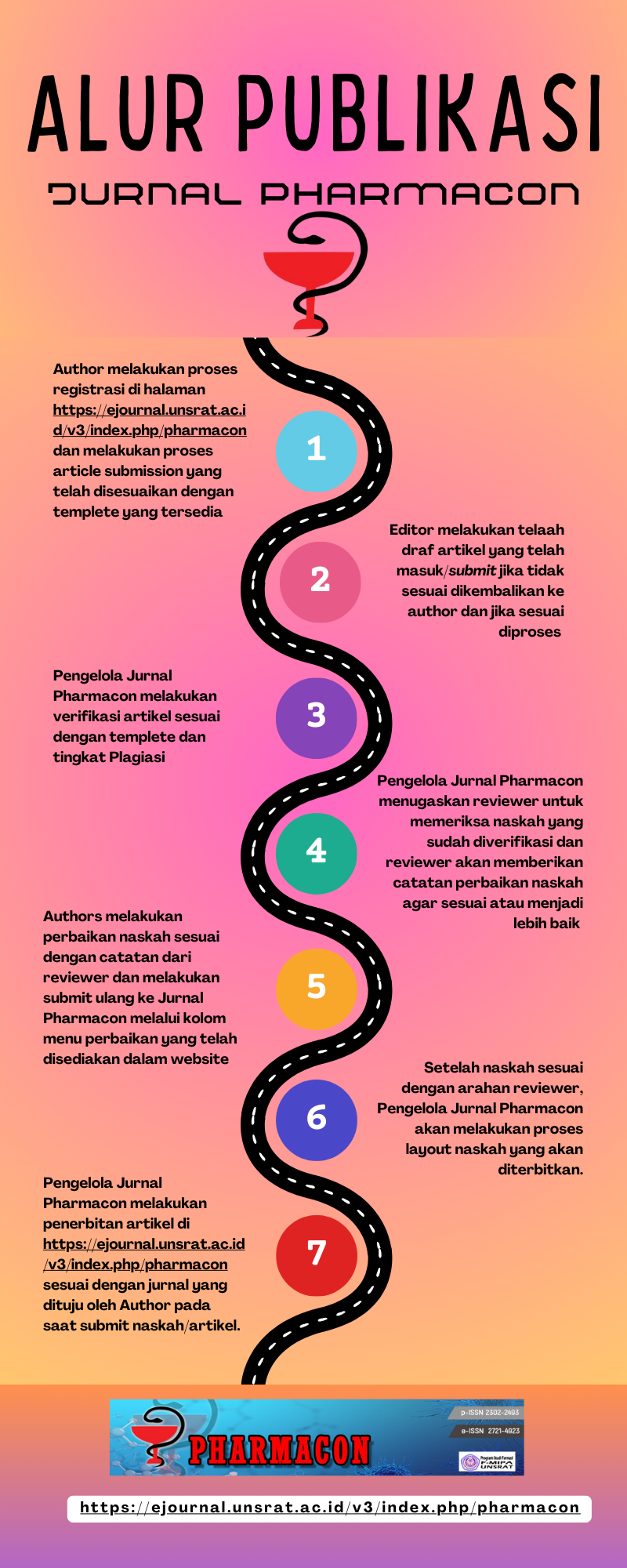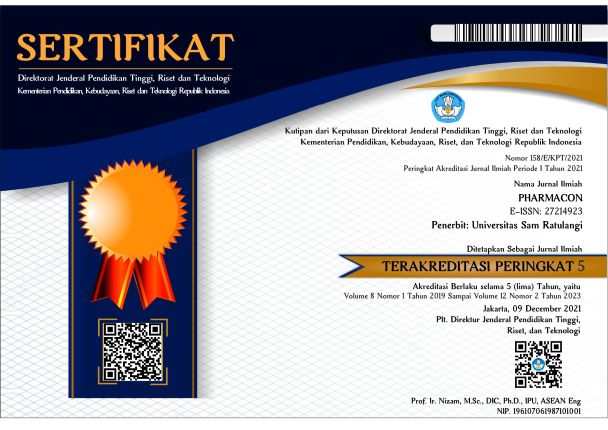Antibacterial Activity Test of Lissoclinum patella Extract Obtained from the Coastal Waters of Parentek Village, East Lembean District, Minahasa Regency
DOI:
https://doi.org/10.35799/pha.13.2024.55990Keywords:
Antibakteri, Ekstraksi, Lissoclinum patella, Staphylococcus aureus, Escherichia coliAbstract
Ascidians are a class of marine tunicates that are included in marine invertebrate organisms. Tunicates (Ascidian) are animals included in the subphylum Urochordata, which have a small bag-like body shape and generally live in marine waters. The body of this animal is covered by a coat (tunic) formed from protein and polysaccharide compounds. This study aims to determine the antibacterial activity of ethanol extract of ascidian Lissoclinum patella against the growth of Staphylococcus aureus and Escherichia coli bacteria. Extraction uses maceration method to extract active compounds from ascidian Lissoclinum patella. The results of the extract were tested whether there was antibacterial activity against Staphylococcus aureus and Escherichia coli bacteria, the test used the Kirby-Bauer agar diffusion method. The results of the test showed antibacterial activity with a marked inhibition zone around the disc paper of the extract test solution on Staphylococcus aureus bacteria with a medium inhibition zone diameter of 7.6 mm and Escherichia coli bacteria with a medium inhibition zone diameter of 6.3 mm.
References
Behrendt, L., A. W. D. Larkum., E. Trampe., A. Norman., S. J. Sorensen, and M. Kuhl. 2012. Microbial Diversity of Biofilm Communities in Microniches Associated with The Didemnid Ascidian Lissoclinum patella. The ISME Journal, 6: 1222-1237.
Brodie, J. E., Devlin, M., Haynes, D., & Waterhouse, J. (2011). Assessment of the eutrophication status of the Great Barrier Reef lagoon (Australia). Biogeochemistry, 106(2), 281-302.
Davis. W. W., Stout, T. R. 1971. Disc Plate Method of Microbiological Antibiotic Assay. Applied Microbiology. 22(4): 659-665.
Donia, M.S., B.J. Hathaway., S. Sudek., M.G. Haygood. M.J. Rosovitz., J. Ravel. and E.W. Schimdt. 2006. Natural Combinatorial Peptide Libraries In Cyanobacterial Symbionts of Marine Ascidians. Nature Publishing Group, 2 (12): 729-735.
Gorwitz RJ, Jernigan DB, Powers JH, et al. 2006. Strategies for clinical management of MRSA in the community: summary of an experts’ meeting convened by the Centers for Disease Control and Prevention.
Gunawan, I. 2007. Penapisan Awal Ekstraksi Senyawa Bioaktif Sebagai Antibakteri serta Uji Toksisitas dan Uji Minimum Inhibitory Concentration (MIC) dari Karang Lunak Asal Perairan Pulau Panggang, Kepulauan seribu [skripsi]. Fakultas perikanan dan Ilmu kelautan, IPB, Bogor.
Hirose, E. and T. Maruyama. 2004. What Are The Benefits In The Ascidian-Prochloron Symbiosis. Endocytobiosis Cell Res, 15: 51- 62.
Jawetz, E., Melnick, J., Adelberg, E. 2005. Mikrobiologi Kedokteran. Ed ke-4. Jakarta: EGC.
Jawetz., et al. 2007. Mikrobiologi Kedokteran Jawetz, Melnick, & Adelberg, Ed.23, Translation of Jawetz, Melnick, and Adelberg’s Medical Microbiology, 23thEd. Alih bahasa oleh Hartanto, H., et al. Jakarta: EGC
Kott. P. (2009). Taxonomic revision of Ascidiacea (Tunicata) from the upper continental slop off north-western Australia. Journal of Natural History, 43(31-32), 1947-1986).
Kuswiyanto. 2015. Bakteriologi : Buku Ajar Analis Kesehatan. Jakarta:Penerbit Buku Kedokteran EGC.
Lalamentik, G. 2017. Aktivitas Antibakteri Ekstrak Karang Lunak Klyxum sp. yang Diperoleh dari Teluk Manado. [skripsi). Program Studi Farmasi FMIPA Universitas Sam Ratulangi, Manado
Lewin, R.A and L. Cheng. 1989. Prochloron: A Microbial Enigma. Chapman and Hall. New York. p 115.
Nofiani, Risa. 2008. Urgensi dan Mekanisme Biosintesis Metabolit Sekunder Mikroba Laut. Jurnal Natur Indonesia. 10 (2): 120-125.
Nybakken, J. W. 1992. Biologi Laut. Suatu Pendekatan Ekologis. PT. Gramedia. Jakarta.
Ortez, J. 11. 2005 Disk Diffusion testing in manual of antimicrobial susce pribility restine Marie B. Coyle (Coord. Ed). American society for Microbiology. America
Paju N., Yamlean P, V., Kojong N. 2013. Uji Efektivitas Salep Ekstrak Daun Binahong (Anredera cordifolia Steenis.) pada Kelinci (Oryctolagus cuniculus) yang Terinfeksi Bakteri Staphylococcus aureus. Pharmacon 2(1):51–61.
Pelczar, M.J., E.S.CHAN. Dasar-dasar Mikrobiologi Edisi ke-2. Jakarta : Penerbit Universitas Indonesia.1988.
Pratiwi. 2008. Mikrobiologi Farmasi. Jakarta: Erlannga
Rosenbach, A. J. F. 1884. Mikro-organismen bel den Wund-infectionskrankhelten des Menschen. JF Bergmann.
Rasyid, A. 2008. Biota Laut Sebagai Sumber Obat-obatan. Oseana, 33(1): 11-18.
Salim, H. H. U. 2016. Pengaruh Aktivitas Antimikroba Ekstrak Bawang Putih (Allium sativum) Terhadap Bakteri Gram Positif (Staphylococcus aureus) dan Gram Negatif (Escherichia coli) Secara In Vitro. Fakultas Kedokteran Universitas
Sarker, S.D.. Latif, Z., and Gray, A.L. 2006. National Product Isolation. New Jersey: Humana Press
Schmidt, W.E., J.T. Nelson., D.A. Rasko., S. Sudek., J.A. Elson., M.G. Haygood. and J. Ravel. 2005. Patellamide A and C Biosynthesis By A Microcin-like Pathway in Prochloron didemni, The Cyanobacterial Symbiont of Lissoclinum patella. The National Academy of Sciences of The USA, 102 (20): 7315-7320.
Sembiring B. 2007. Teknologi Penyiapan Simplisa Terstandar Tanaman Obat. Warta Puslitbangbun. 13(2): 4-8
Sitepu, R., Ririn, N., Rollando, R. 2020. Aplikasi Metode Bioautografi Dalam Penelusuran Daya Antibakteri Ekstrak Pegagan (Centella asiatica (L.). Jurnal Katalisator. Malang : Universitas Ma Chung.
Susanto, D., Sudrajat dan R. Ruga. 2012. Studi Kandungan Bahan Aktif Tumbuhan Meranti Merah (Shorea leprosula Miq) Sebagai Sumber Senyawa Antibakteri. Jurnal Kesehatan. 11(2): 1-15
Suparno. 2005. Kajian Bioaktif spons laut (forifera: Demospongiae) Suatu Peluang Alternative Pemanfaatan Ekosistem Karang Indonesia Dalam Bidang Farmasi.[skripsi]. Institute Pertanian Bogor
Suryanto E. 2012. Fitokimia Antioksidan. Putra Media Nusantara: Surabaya Tanjung.
Timotius, 1982, Dasar Mikrobiologi, 56, Universitas Ksatya Wacana, Salatiga.
Waluyo, L., 2004, Mikrobiologi Umum, Malang, UMM press.
Downloads
Published
How to Cite
Issue
Section
License
Copyright (c) 2024 Hilda Kiwol, Defny Wewengkang, Erladys Rumondor

This work is licensed under a Creative Commons Attribution-NonCommercial 4.0 International License.
Authors who publish with this journal agree to the following terms:
- Authors retain copyright and grant the journal right of first publication with the work simultaneously licensed under a Creative Commons Attribution-NonCommercial 4.0 International License that allows others to share the work with an acknowledgement of the work's authorship and initial publication in this journal.
- Authors are permitted and encouraged to post their work online (e.g., in institutional repositories or on their website) prior to and during the submission process, as it can lead to productive exchanges, as well as earlier and greater citation of published work (See The Effect of Open Access)










